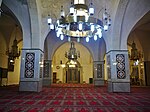The Cave of the Patriarchs or Tomb of the Patriarchs, known to Jews by its Biblical name Cave of Machpelah (Biblical Hebrew: מְעָרַת הַמַּכְפֵּלָה, romanized: , lit. 'Cave of the Double') and to Muslims as the Sanctuary of Abraham (Arabic: الحرم الإبراهيمي, romanized: ), is a series of caves situated 30 kilometres (19 mi) south of Jerusalem in the heart of the Old City of Hebron in the West Bank. According to the Abrahamic religions, the cave and adjoining field were purchased by Abraham as a burial plot, although most historians believe the Abraham-Isaac-Jacob narrative to be primarily mythological. The site is considered a holy place in Judaism, Christianity, and Islam.
Over the cave stands a large rectangular enclosure dating from the Herodian era. During Byzantine rule of the region, a Christian basilica was built on the site; the structure was converted into the Ibrahimi Mosque following the Muslim conquest of the Levant. By the 12th century, the mosque and its surrounding regions had fallen under Crusader-state control, but were retaken in 1188 by the Ayyubid sultan Saladin, who again converted the structure into a mosque. In 1119 CE, a monk found bones inside the cave, believing them to be the bones of the patriarchs.
During the Six-Day War of 1967, the entire Jordanian-occupied West Bank was seized and occupied by the State of Israel, after which the mosque was divided, with half of it repurposed as a synagogue. In 1968, special Jewish services were authorized outside the usual permitted hours on the Jewish New Year and Day of Atonement, leading to a hand-grenade attack on 9 October which injured 47 Israelis; and a second bombing on 4 November, which wounded 6 people. In 1972, the Israeli government increased the Jewish prayer area. New changes to the "status quo" were made by Israeli authorities in 1975, which again led to protests by Muslims.
In 1976, a scuffle took place between Jewish and Muslim worshippers, during which a Quran was torn. Muslim and Arab figures went to Hebron the next day to protest what was called a "profanation of the Quran". The Tomb was closed and a curfew was imposed on the whole city. A few days later, about two hundred Arab youths entered the Tomb and destroyed Torah scrolls and prayer books. In May 1980, an attack on Jewish worshippers returning from prayers at the tomb left 6 dead and 17 wounded. In 1994, the Cave of the Patriarchs massacre occurred at the Ibrahimi Mosque, in which an armed Israeli settler entered the complex during the Islamic holy month of Ramadan and opened fire on Palestinian Muslims who had gathered to pray at the site, killing 29 people, including children, and wounding over 125.









